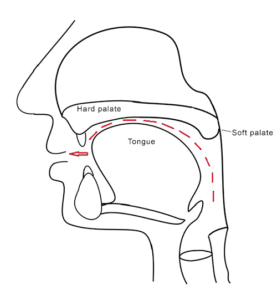Your child will be invited to this clinic if there is a suspicion that their palate is not working effectively, resulting in nasal speech caused by too much air passing through the nose.
The soft palate usually seals against the back of the throat to separate the mouth and nose (see larger version of diagram). This means that you can build up pressure in your mouth, which is needed for most speech sounds.
Your speech and language therapist will advise if this clinic is right for your child and will explain the process to you before referring you to this clinic
What to expect
This clinic is usually run by our speech and language therapists. They will guide you and your child through the various stages described below. When all of the assessments have been completed, the team will review the results together. This may or may not be on the same day. Usually you will be invited back for a further appointment so we can fully discuss the results and treatment options with you.
Speech assessment
The speech and language therapists will assess your child’s speech. Your child will be asked to repeat a range of words and sentences so we can listen to different speech sounds.
You will be asked for your consent to record this assessment. This is helpful to capture your child’s talking at this stage so that, if any treatment is offered, we can compare your child’s speech before and after treatment.
Nasometry
Nasometry allows us to assess resonance (the balance of air through the nose and mouth). Your child will be asked to wear a headset with a plate which rests on their upper lip allowing separate measurement of the air through the nose and mouth. This will then create a score which will be explained to you on the day.
Videofluoroscopy (video x-ray)
A speech and language therapist will walk with you to the x-ray department. There, you will meet the radiographer who will help to seat your child comfortably and explain the process. Your child will sit in a chair and the radiographer will run a video x-ray as they speak. The speech and language therapist will tell your child what to say.
A parent / guardian will be able to be with the child and stand nearby wearing a lead apron. If your child is more confident, you may be asked to come into the same room but stand behind a screen instead.
Nasendoscopy
Depending on what we see when we do the x-ray, we sometimes need to carry out a nasendoscopy to get more information. This is where a very skinny, flexible, camera is placed into the nostril to look at the back of the palate.
If your child needs a nasendoscopy, the speech and language therapist will explain exactly what will happen first. Your child may be given some local anaesthetic in the form of a nasal spray.
Although the scope is long, only a very small section will be put inside your child’s nose. They will then be asked to count and repeat some words and phrases while the camera looks at their palate movement.
You will be able to sit with your child and hold their hand if they would like.
Support for children who are worried about tests
If you think your child might find some of the tests difficult, we can arrange different kinds of support. For example, a distracting activity, a “dress rehearsal” or support from a play worker or clinical psychologist. Just let us know if this will be helpful.
Who you may see
- Speech and language therapists
- Surgeons
- Radiographer
If you do not meet our consultant plastic surgeon on the same day as the clinic, we will review the results together and may invite you back for an appointment to discuss the treatment options with the surgeon.
Location
Speech and Language Therapy department
Level 3, Salisbury District Hospital
Salisbury District Hospital address and travel information
Please check your letter to confirm where the clinic will be held as this can sometimes change.



